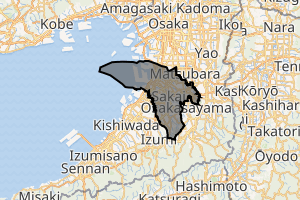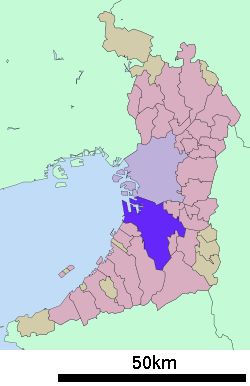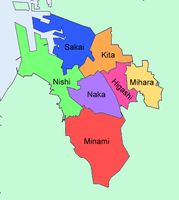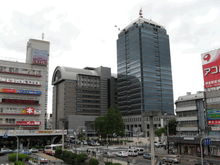Sakai
Sakai (堺市, Sakai-shi) is a city located in Osaka Prefecture, Japan, on the edge of Osaka Bay at the mouth of the Yamato River. It has been one of the largest and most important seaports of Japan since the medieval era.
Sakai 堺市 | |
|---|---|
| Sakai City[1] | |
 From top left: Daisen Kofun, Old Sakai Lighthouse, Ruins of Rikyu's house, Ōtori taisha, Myōkoku-ji, Skyline with Daisen kofun in the center | |
 Flag  Emblem | |

Location of Sakai in Osaka Prefecture | |
 | |
 Sakai Location in Japan | |
| Coordinates: 34°34′24″N 135°28′59″E | |
| Country | Japan |
| Region | Kansai |
| Prefecture | Osaka Prefecture |
| Government | |
| • Mayor | Hideki Nagafuji (from June 2018) |
| Area | |
| • Total | 149.82 km2 (57.85 sq mi) |
| Population (June 1, 2019) | |
| • Total | 828,741 |
| • Density | 5,500/km2 (14,000/sq mi) |
| Symbols | |
| • Tree | Willow |
| • Flower | Iris |
| • Bird | Shrike |
| • Flowering tree | Tsutsuji |
| Time zone | UTC+9 (JST) |
| City hall address | 3-1 Minami-Kawaramachi, Sakai-ku, Sakai-shi, Osaka-fu 590-0078 |
| Website | www |
| Sakai | |||||
|---|---|---|---|---|---|
| Japanese name | |||||
| Kanji | 堺市 | ||||
| Hiragana | さかいし | ||||
| Katakana | サカイシ | ||||
| |||||
Following the February 2005 annexation of the town of Mihara (from Minamikawachi District), the city grew to the fourteenth most populous city in Japan,[2] with 828,741 residents as of June 1, 2019.[3]
The current city was legally founded on April 1, 1889, according to the laws of Imperial Japan. Sakai became a designated city in April 2006[4] giving it a greater measure of self-determination in governmental affairs. It is divided into seven districts.
Sakai is known for its keyhole-shaped burial mounds, or kofun, which date from the 5th century. The largest of these, Daisen Kofun, is believed to be the grave of the Emperor Nintoku and is the largest grave in the world by area. Once known for samurai swords, Sakai is now famous for the quality of its kitchen knives; most high-quality Japanese cutlery originates in Sakai, and its production is a major industry in the city.
History
The area that would later become known as Sakai has been inhabited since approximately 8,000 BC.[5]
During the Yamato dynasty between 300 and 500 AD, the Mozu Tumulus Cluster was built from over one hundred burial mounds.[5] The name "Sakai" appears in Fujiwara Sadoyori's poetry by 1045.[6]
Tradition holds that 10,000 homes burned to the ground in 1399.[6]
Medieval Sakai was an autonomous city run by merchant citizens. During the Muromachi and Sengoku periods from about 1450 to 1600, Sakai became one of richest cities in Japan by using its location at the mouth of the Yamato River to connect foreign trade with inland trade to the Yamato Province. It was a leading producer of textiles and ironwork.[7] In those days, it was said that the richest cities were Umi no Sakai, Riku no Imai (tr. "along the sea, Sakai; inlands, Imai"; the latter is now a part of Kashihara, Nara). The famous Zen Buddhist priest Ikkyū chose to live in Sakai because of its free atmosphere.
The first reliable account of the city is dated to the 1480s and contains publicly issued legal notices, which suggests that the city had a governing council at that point. By the 1530s, the population was around 40,000 residents, almost all of which earned a living through commercial enterprises and some of which were the wealthiest people in Japan. At this time, Sakai was administered by an oligarchy of powerful merchants. The government had ten divisions machi that were subordinate to the representative council of wealthy townsmen known as the egoshu.[7][8]
Sen no Rikyū, known as the greatest master of the tea ceremony, was originally a merchant of Sakai. Because of the close relationship between the tea ceremony and Zen Buddhism and because of the prosperity of its citizens, Sakai was one of the main centers of the tea ceremony in Japan.
In the Sengoku period, some Christian priests, including Francis Xavier in 1550, visited Sakai and documented its prosperity. Gaspar Vilela described the town as the safest place in the area when he visited in 1561.[9] He also mentioned that the city was "governed by consuls like Venice in Italy", although he didn't elaborate on what he meant by "like consuls".[7][10]
After the coming of Europeans, Sakai became a manufacturing base of firearms and a daimyō, Oda Nobunaga, was one of their important customers. During his ambitious attempt to unify Japan, Nobunaga attempted to take the autonomy privilege from Sakai. Sakai's citizens denied his order and pitched a desperate battle against his army. Most citizens fled and Sakai was burned and seized by Nobunaga. After the death of Nobunaga in 1582, one of his men, Toyotomi Hideyoshi, seized power and abolished the autonomous system of Sakai and reportedly forced the local merchants to move to central Osaka near his stronghold to weaken the powerful business community there.[11] Sakai became a prosperous city again under his reign.
In 1615, Sakai burned to the ground in the Osaka summer battle.[6]
Sakai was still an important trade center during the Edo period but was involved only in inland trade due to the sakoku policy of the Tokugawa government. At the end of this era, Westerners again landed in Sakai but it resulted in a tragic incident because the Japanese citizenry and the foreigners were ignorant of each other's ways. French sailors from the Dupleix and Sakai citizens clashed; some French were killed, and subsequently the Japanese responsible for these deaths were sentenced to death by seppuku. This incident is called the Sakai incident (堺事件, Sakai-jiken).
In modern times, Sakai is an industrial city with a large port. As such, its western area suffered widespread damage from bombing raids during the Second World War. It is now known for its knives and is the home of Shimano bicycle parts. With a population of over 800,000, it is the largest suburb of Osaka City and the fourteenth-largest city in Japan.
Education
Primary and secondary schools
The city previously had a North Korean school, Sakai Korean Elementary School (堺朝鮮初級学校).[12]
International relations
Sister cities



Friendship cities



Notable people
- Yuki Morisaki, Japanese chef and entertainer
- Reon Kadena
- Emperor Nintoku
- Gyōki
- Ikkyū
- Sen no Rikyū
- Tsuda Sōgyū
- Imai Sōkyū
- Ōuchi Yoshihiro
- Takeno Jōō
- Oreskaband
- Nobuaki Kakuda
- Hiroki Suzuki, Japanese actor and singer
- Kentaro Kobuchi and Shunsuke Kuroda, the members of the music group Kobukuro
- Akiko Yosano, Japanese poet and novelist
- Ryumon Yasuda, Japanese Painter and sculptor
- Hideo Nomo worked in Shin-nittetsu Sakai and played on its club team before he was scouted by the Kintetsu Buffaloes
- Yudetamago, manga artist duo (attended Hatsushiba High School in Higashi-ku)
- Akio Mori, a well known K-1 kickboxer known as Musashi (kickboxer)
- Akira Nagata, actor and singer/vocalist, member of J-pop group Run&Gun
References
- Sakai official English name Archived February 26, 2010, at the Wayback Machine
- Sakai City profile Archived December 11, 2006, at the Wayback Machine. Accessed March 13, 2007. Note that although the reference refers to Sakai as the fourteenth-largest city in Japan, this reference excludes Tokyo.
- Sakai City Department of Planning, Head of Statistical Research (堺市企画部調査統計担当, Kikakubu Chōsa Tōkei Tantō). Accessed January 19, 2018.
- "Tokyo pollsters in the money", Yomiuri Shimbun, February 17, 2007. Accessed March 13, 2007.
- http://www.sakai-tcb.or.jp/english/about_sakai/
- http://www.city.sakai.lg.jp/english/visitors/whats/history.html
- The Oxford Handbook of Cities in World History edited by Peter Clark https://books.google.com/books?id=z09oAgAAQBAJ&pg=PA331&lpg=PA331&dq=Gaspar+Vilela+sakai+consuls
- An Introduction to the History of Japan by Katsuro Hara https://books.google.com/books?id=k-lBAAAAIAAJ&pg=PA241&lpg=PA241&dq=sakai+japan+autonomous+merchant
- http://www.japantimes.co.jp/life/2015/04/11/travel/sakai-keyhole-history-osaka/#.Vr2JV_krJjU
- "Japan's oldest 'autonomous' city splits over Osaka Metropolis Plan – Xinhua | English.news.cn". news.xinhuanet.com. Retrieved May 8, 2016.
- http://news.xinhuanet.com/english/world/2013-09/19/c_132733667.htm
- "|script-title=ja:ウリハッキョ一覧 |publisher=Chongryon |date=November 6, 2005 |accessdate=October 15, 2015}}}} ([https://www.webcitation.org/6cHKwmz4m?url=http://web.archive.org/web/20051106010302/http://www.chongryon.com/j/cr/link3.html Archive).
External links
- Sakai City official website (in Japanese)



